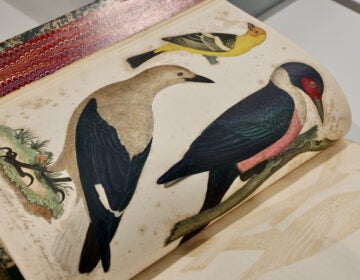Sunrise show-stopper
ListenTime marches on, but sunrise will be stuck at 7:22 a.m. for more than a week. Winter constellations becoming prominent in the night sky. Four planets are available for viewing as we greet 2014.
December 30, 2013
[Dave Heller] Time to greet the new year except for one possible impediment: The sun dial seems to be stuck. Helping us set our time pieces for 1-1-14 is Derrick Pitts, chief astronomer at the Franklin Institute. What’s the cure, Derrick? A new battery?
[Derrick Pitts] If we just sit and wait, everything will clear itself up without any problem at all.
I can’t wait!
Well, you have to. I think you’re stuck because it’s the Earth that has to continue its motion around the sun before things change.
Wait, the Earth has stopped?
Yeah, well, not exactly. We’ve come to a point in the Earth’s orbit around the sun where it seems as if our sunrise times for this particular part of the planet are sort of stuck at a particular location right now: 7:22 a.m. So for the next week, your sunrise time is going to be 7:22 a.m. Now normally the sunrise time would be changing almost every day. And in this case in this time of the year, the sunset time would be coming later and later and later. But we’ve reached our maximum late sunrise time for the year, and the only thing that can happen from now on is that sunrise times begin to come earlier and earlier. But that happens next week, so we’re at that point at the Earth’s orbit around the sun where we’re at our closest approach to the sun, just about (that would be next week too), and we’re sort of at that dwell point where the sunrises are what they are.
“We’ve come to a point in the Earth’s orbit around the sun where it seems as if our sunrise times for this particular part of the planet are sort of stuck at a particular location right now: 7:22 a.m. So for the next week, your sunrise time is going to be 7:22 a.m.”
Derrick Pitts
-

Photo by Flickr user Khirol Amir
Are sunsets also at a dwell point?
That’s a great question. As it turns out, they aren’t. Sunsets are beginning to come later every day by a whole minute. So we’re gaining some time on the backend of the day, but we’re still at a point where we have a very few number of hours of sunshine during the course of the day and that’s because of the late sunrises. Now, next week when the sunrises begin to come earlier, then the number of hours of daylight per day is growing on both ends of the day and we’ll see the day lengthen much more quickly.
Out of curiosity, is there a flip side when the sunset time is fixed for a while?
Yeah, that happens in the summer when the sunset time comes around in late June and we see it sitting at, uh, I think the time is about 8:34 in the evening, if I’m remembering correctly off the top of my head. Just sits there at 8:34 for a few days, and the same happens with the sunrise times — they come earlier and earlier and they sit there for a little while. But they’re sort of staggered and out of kilter with each other, and the reason why is we have to remember that the Earth’s orbit is not circular but it’s elliptical. And because of the ellipticity of the orbit, that changes the orbital speed around the sun, and that throws all kinds of little monkey wrenches into the system of trying to keep our days at exactly 24 hours. The days aren’t exactly 24 hours, really, according to the Earth and its rotational axis and as it orbits around the sun. But we here on the planet need it to be an exact 24 hours so everything can run smoothly and we can be sure that you can make the connection between the train and the plane on time.
-

Winter sunrise. Photo by Flickr user siegertmarc
Too enticing to consider summer at this juncture. Let’s come back to winter: Lots of constellations to be seen.
Well, you know, you’re now able to see the very, very last of the summer constellations. The very last.
Oh, these aren’t 2014 previews?
Oh, no no no …
… Reruns?
Yeah, they’re reruns actually, sure. Because we can just barely see the top of Cygnus the Swan on the western horizon at sunset, and that’s a major summer constellation. But what that means is that the major fall constellations are passed, you know, directly overhead by sunset time. While over on the eastern side of the sky we can see the main constellations of winter making their way up, not long after sunset already. So we have Auriga the Charioteer; Taurus, of course, up nice and high; we can see Orion is well above the horizon at the same time; and of course Gemini is coming up right behind it along with the Hunting Dogs of Orion. So the winter constellations are now moving in to the exact right spot in the sky by 9 p.m. So we can see them now fully.
But the really cool thing about that is that in a very short period of time if we’re up late enough, by midnight we can start to see Leo the Lion on the eastern horizon which is the main constellation of spring. So in a sense, the way I sort of think of it when we get to this portion of the year, where we’re seeing the very last of the summer constellations, winter constellations up full, spring constellations over on the eastern side of the sky very late at night — for me, winter, it’s all downhill from here headed right into spring.
-

Photo by Flickr user Jason Jenkins
And if the cloud cover cooperates tomorrow night, what planets are there to be seen on New Years Eve?
Beautiful in the evening sky just after sunset we can see Venus, nice and bright. Can’t miss it without any problem at all. Then over on the eastern side of the horizon at the same time, Jupiter — the largest planet of the solar system — is up. But the real time to see the sky for planets is at about 6:30 a.m. in the morning. Not bright enough yet for the sun to interfere, and what this gives us then is Jupiter high in the western sky with Mars high in the south. And then we find over on the eastern side of the sky down low at the same time is Saturn. So in an evening and on into the next morning, we can see four of the five brightest planets of the solar system. Venus in the evening, and then in the predawn sky: Jupiter, Mars, Saturn heading over toward the east. The thing to look out for is watch how the moon slides along among each of the planets during the course of the next week and a half.
Though I have to admit, I’m not sure I’ll be bright enough 6:30 in the morning on New Years Day. Derrick, best wishes to you and yours for a happy and healthy 2014.
Thanks, and same to you, Dave.
WHYY is your source for fact-based, in-depth journalism and information. As a nonprofit organization, we rely on financial support from readers like you. Please give today.




